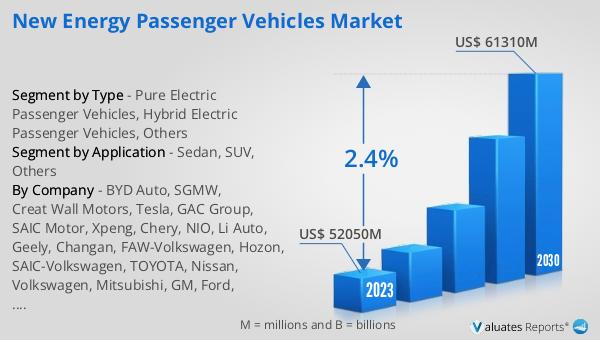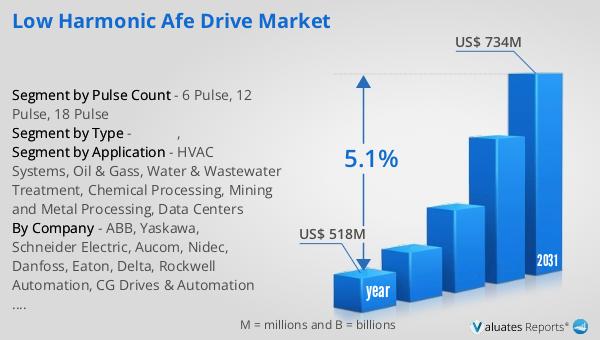What is Global New Energy Passenger Vehicles Market?
The Global New Energy Passenger Vehicles Market refers to the segment of the automotive industry that focuses on vehicles powered by alternative energy sources rather than traditional fossil fuels. This market includes a variety of vehicles such as pure electric vehicles (EVs), hybrid electric vehicles (HEVs), and other types of new energy vehicles (NEVs). These vehicles are designed to reduce carbon emissions and reliance on non-renewable energy sources, contributing to a more sustainable and environmentally friendly transportation system. The market has seen significant growth due to advancements in battery technology, government incentives, and increasing consumer awareness about environmental issues. As countries around the world strive to meet their climate goals, the demand for new energy passenger vehicles is expected to continue rising, making this market a crucial component of the global automotive industry.

Pure Electric Passenger Vehicles, Hybrid Electric Passenger Vehicles, Others in the Global New Energy Passenger Vehicles Market:
Pure Electric Passenger Vehicles (EVs) are powered entirely by electricity stored in batteries, which are charged through external power sources such as charging stations. These vehicles produce zero tailpipe emissions, making them an environmentally friendly option. They are known for their quiet operation, lower maintenance costs, and the ability to be charged at home or at public charging stations. However, the range of pure electric vehicles can be a concern for some consumers, although advancements in battery technology are continually improving this aspect. Hybrid Electric Passenger Vehicles (HEVs) combine a conventional internal combustion engine with an electric propulsion system. This combination allows for better fuel efficiency and reduced emissions compared to traditional vehicles. HEVs can switch between or combine the two power sources to optimize performance and efficiency. Plug-in Hybrid Electric Vehicles (PHEVs) are a subset of HEVs that can be charged via an external power source, allowing them to operate on electric power alone for shorter distances. This makes them a versatile option for those who want the benefits of electric driving without the range anxiety associated with pure EVs. Other types of new energy passenger vehicles include Fuel Cell Electric Vehicles (FCEVs), which use hydrogen to generate electricity through a chemical reaction. FCEVs produce only water vapor as a byproduct, making them another zero-emission option. However, the infrastructure for hydrogen refueling is still limited, which can be a barrier to widespread adoption. Additionally, there are vehicles that use alternative fuels such as biofuels or natural gas, which also contribute to reducing the environmental impact of transportation. Each type of new energy passenger vehicle offers unique benefits and challenges, and the choice between them often depends on factors such as driving habits, availability of charging or refueling infrastructure, and personal preferences. As technology continues to evolve, the options for consumers in the new energy passenger vehicle market are expected to expand, providing more choices for sustainable transportation.
Sedan, SUV, Others in the Global New Energy Passenger Vehicles Market:
The usage of Global New Energy Passenger Vehicles Market spans various vehicle types, including sedans, SUVs, and others. Sedans, being one of the most popular vehicle types, have seen a significant shift towards new energy options. Electric sedans offer a smooth and quiet ride, with the added benefit of lower operating costs due to reduced fuel and maintenance expenses. They are ideal for urban commuting and daily use, providing a practical and eco-friendly alternative to traditional gasoline-powered cars. Hybrid sedans, on the other hand, offer the flexibility of extended range and better fuel efficiency, making them suitable for both city driving and longer trips. SUVs, known for their spacious interiors and versatility, are also embracing new energy technologies. Electric SUVs provide the same benefits as electric sedans, with the added advantage of more cargo space and the ability to handle rougher terrains. This makes them a popular choice for families and outdoor enthusiasts who want to reduce their carbon footprint without sacrificing utility. Hybrid SUVs offer a balance between power and efficiency, allowing for longer trips without frequent refueling stops. They are particularly appealing to those who need a vehicle that can handle diverse driving conditions while still being environmentally conscious. Other types of vehicles in the new energy passenger vehicle market include minivans, hatchbacks, and luxury cars. Minivans, often used for transporting larger groups of people, benefit from the reduced emissions and lower operating costs of new energy technologies. Electric and hybrid minivans provide a comfortable and eco-friendly option for families and businesses that require a spacious vehicle. Hatchbacks, known for their compact size and practicality, are also available in electric and hybrid versions. These vehicles are perfect for urban environments where space is limited, offering an efficient and sustainable mode of transportation. Luxury cars in the new energy market cater to consumers who want high-performance vehicles with advanced features and a reduced environmental impact. Electric and hybrid luxury cars combine cutting-edge technology with sustainability, providing a premium driving experience without compromising on eco-friendliness. Overall, the Global New Energy Passenger Vehicles Market offers a wide range of options for different vehicle types, catering to various consumer needs and preferences. As technology continues to advance and infrastructure improves, the adoption of new energy vehicles across all segments is expected to grow, contributing to a more sustainable future for transportation.
Global New Energy Passenger Vehicles Market Outlook:
The global New Energy Passenger Vehicles market was valued at US$ 52,050 million in 2023 and is anticipated to reach US$ 61,310 million by 2030, witnessing a CAGR of 2.4% during the forecast period 2024-2030. According to the passenger car market analysis report released by the Passenger Federation, the retail sales of new energy passenger cars in China will reach 640,000 in December 2022, a year-on-year increase of 35.1%, maintaining an upward trend. The annual retail sales of new energy passenger vehicles reached 5.674 million units, a year-on-year increase of 90.0%.
| Report Metric | Details |
| Report Name | New Energy Passenger Vehicles Market |
| Accounted market size in 2023 | US$ 52050 million |
| Forecasted market size in 2030 | US$ 61310 million |
| CAGR | 2.4% |
| Base Year | 2023 |
| Forecasted years | 2024 - 2030 |
| Segment by Type |
|
| Segment by Application |
|
| Production by Region |
|
| Consumption by Region |
|
| By Company | BYD Auto, SGMW, Creat Wall Motors, Tesla, GAC Group, SAIC Motor, Xpeng, Chery, NIO, Li Auto, Geely, Changan, FAW-Volkswagen, Hozon, SAIC-Volkswagen, TOYOTA, Nissan, Volkswagen, Mitsubishi, GM, Ford, Renault |
| Forecast units | USD million in value |
| Report coverage | Revenue and volume forecast, company share, competitive landscape, growth factors and trends |
